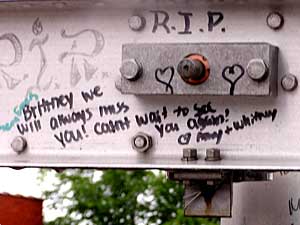|
Audio
Photos
Resources
Your Voice
|
Pedestrian-train accidents on the rise
August 17, 2004
 |
| Friends of a teenage girl killed at this pedestrian crossing in Moorhead, have left messages on the crossing gate as a memorial. (MPR Photo/Bob Reha) |
Moorhead, Minn. — Trains are a common sight in the Fargo-Moorhead area. As many as 70 Burlington Northern Santa Fe trains rumble through town each day. A double-track mainline runs through the two communities, like a center line on a highway.
A third track skirts along the north side of downtown. Since the land is flat, you can hear and see a train coming from a long distance. Under those circumstances, it's hard to understand how someone could get hit by a train.
 | |||
"If someone's going to try and beat the train across, to save some time, it's still going to happen," says Sgt. Shannon Monroe of the Moorhead Police Department. Monroe says people are misjudging how fast a train is moving, and that is often a fatal mistake. Monroe remembers being called to an accident where a man in his 70s had been hit by a train. He apparently had not seen the train, and walked onto the tracks in front of the locomotive. A witness dialed 911.
"The call was a cell phone caller, who was saying the person was coughing and stuff yet. Obviously it was a gory scene," says Monroe. "But there was a thought that the person could possibly be alive. We got there, basically it's 10, 12, blocks away, so we were there pretty quick. The person was gone already."
Monroe says people aren't paying attention. They're easily distracted. He says inattention and impatience are getting people killed.
"Everybody seems to be in a rush all the time. Everybody is running behind. It just seems to be a matter of people making poor decisions," says Monroe. "Taking that risk, thinking they're going to be fine. They try to beat it across the tracks as the arms are coming down. They see a train in the distance and they think they're timing it just right."
 | |||
What's happening in Fargo-Moorhead mirrors a national trend. Statistics from the Federal Railroad Administration show 898 pedestrians were killed or injured by trains in 2003.
Representatives of the Burlington Northern Santa Fe railroad say they are aware of the problem. Spokesman Steve Forsberg says most of the crossings in Fargo-Moorhead have gates to stop auto traffic. But few have gates at sidewalks, to stop pedestrians from crossing. He says there are plans to add safety gates for pedestrian crossings. But he cautions, adding the gates will not solve the problem.
"In an almost perverse way, it seems that we seem to be taking more risks. Our train crews can tell on numerous occasions how many near misses they had. Only the collisions are making the news," says Forsberg. "What never makes the news is the number of near misses there were by people who took the risk and managed to miraculously avoid the fatality."
Forsberg says on average, 12 people or vehicles are struck by a train each day in the United States. Forsberg says the best way to address the problem is with education.
 | |||
Leann Wallin works for the city of Moorhead's engineering department. She's also a certified instructor for the Operation Lifesaver program, which was founded 30 years ago by two Union Pacific employees. Wallin visits with civic groups and schools, distributing fact sheets and showing videos.
Wallin says the biggest surprise for people in her class is finding out how quickly a train moves.
"You really only have about 20 seconds from the time the gates come down and the lights go on," says Wallin. "People are amazed, that's a pretty short amount of time."
Wallin says it's impossible for a locomotive weighing hundreds of tons to stop in 20 seconds. She says as difficult as it sounds, some people don't understand that.
Wallin thinks adding gates at pedestrian crossings will help. She says educating people to be safer and smarter around railroad tracks is the key to avoiding tragedy.
|
News Headlines
|
Related Subjects
|
